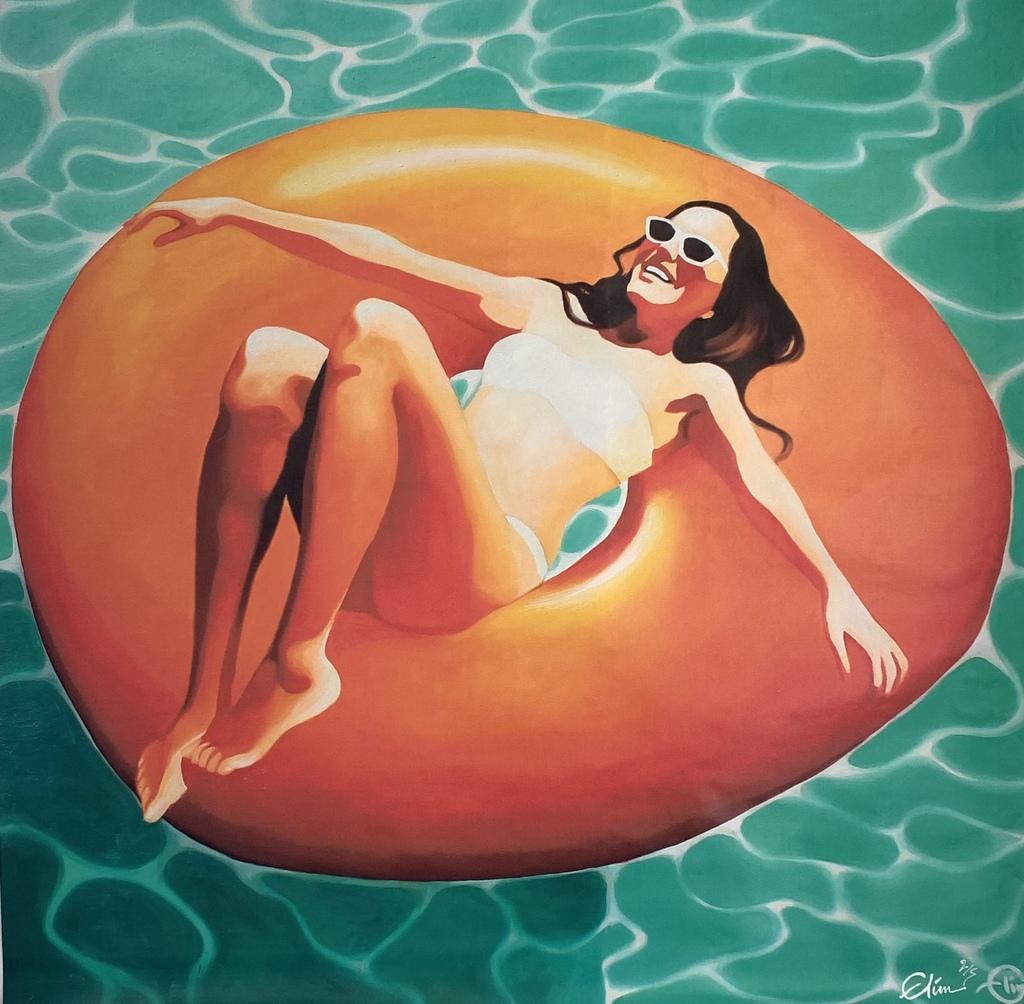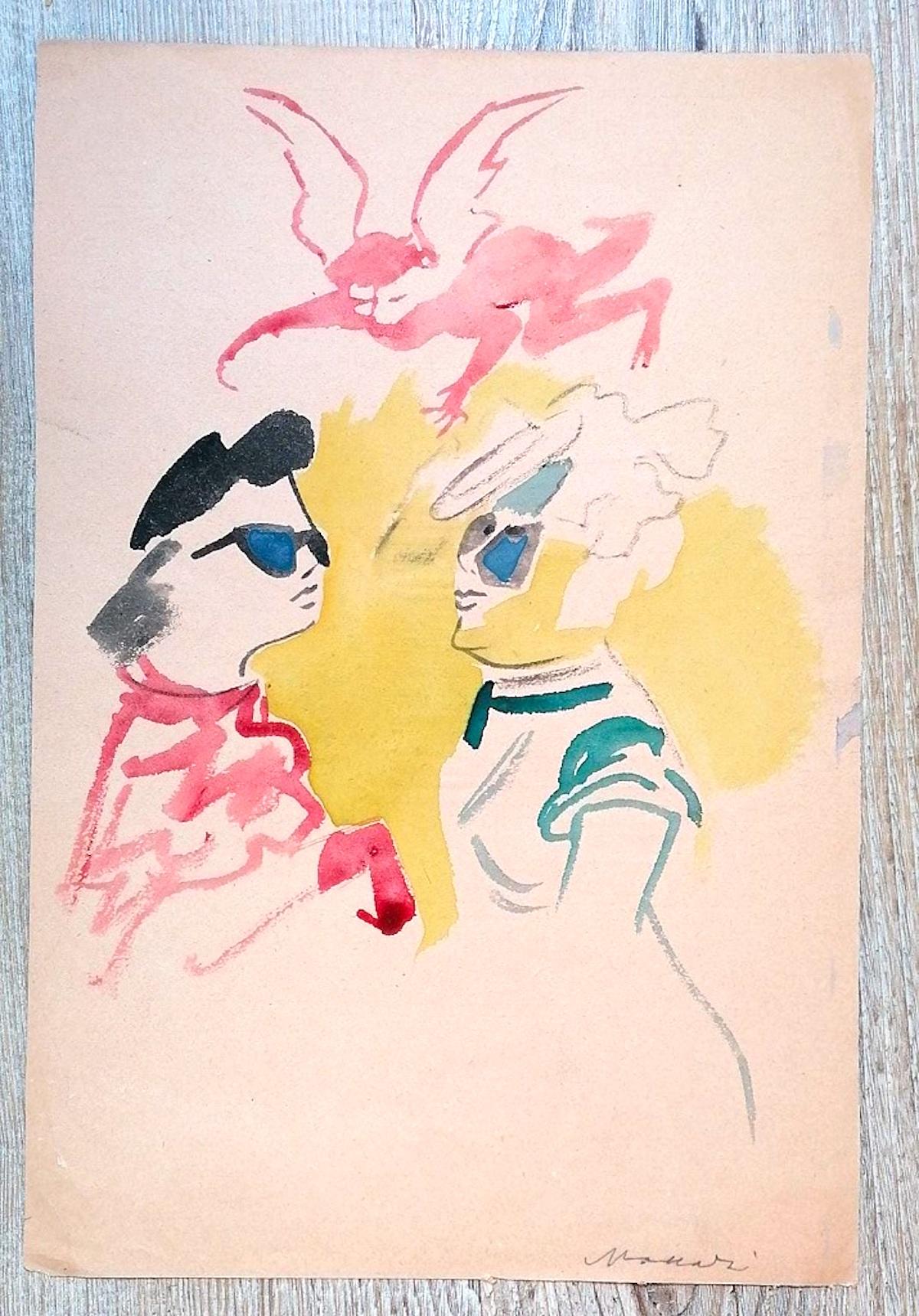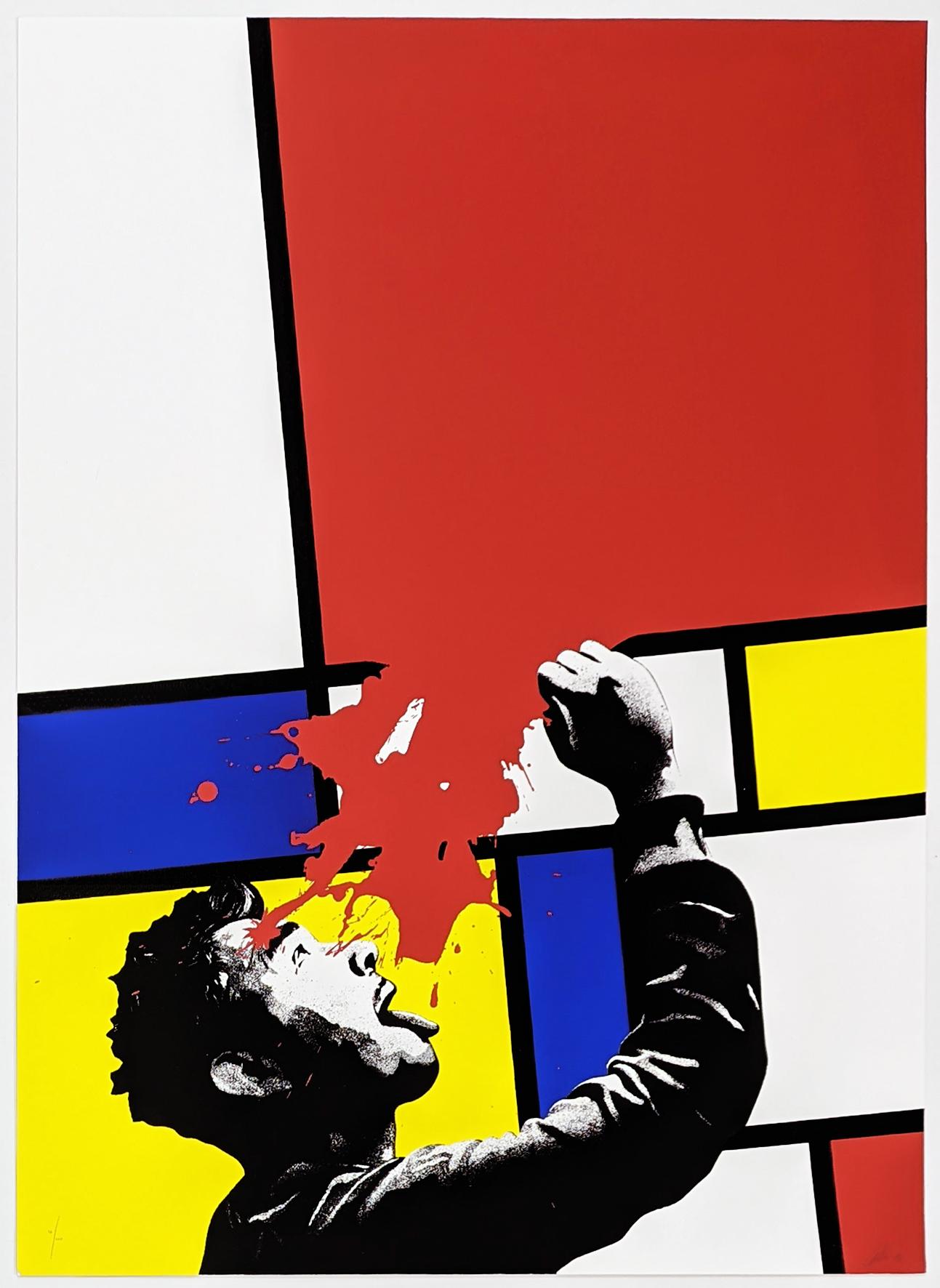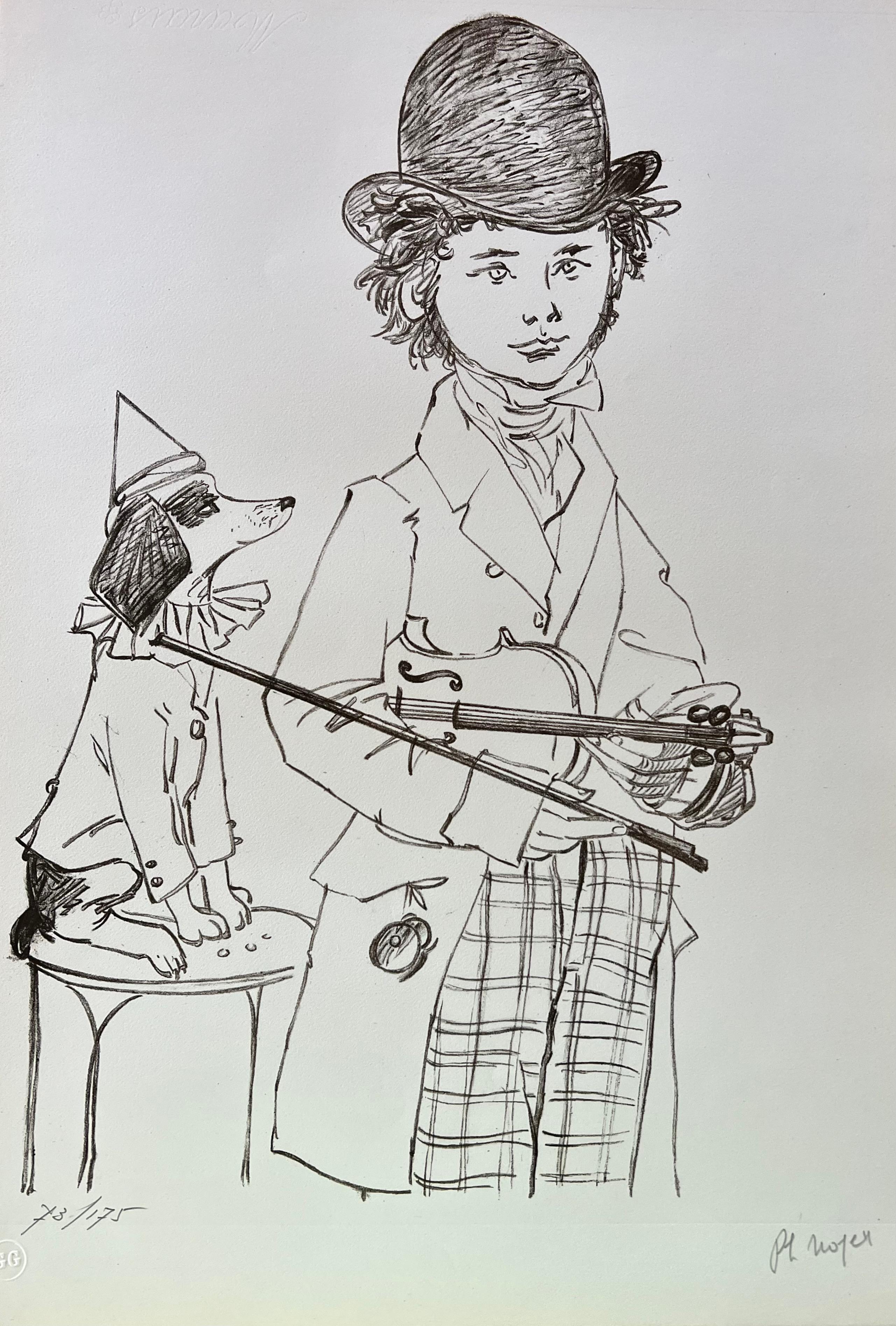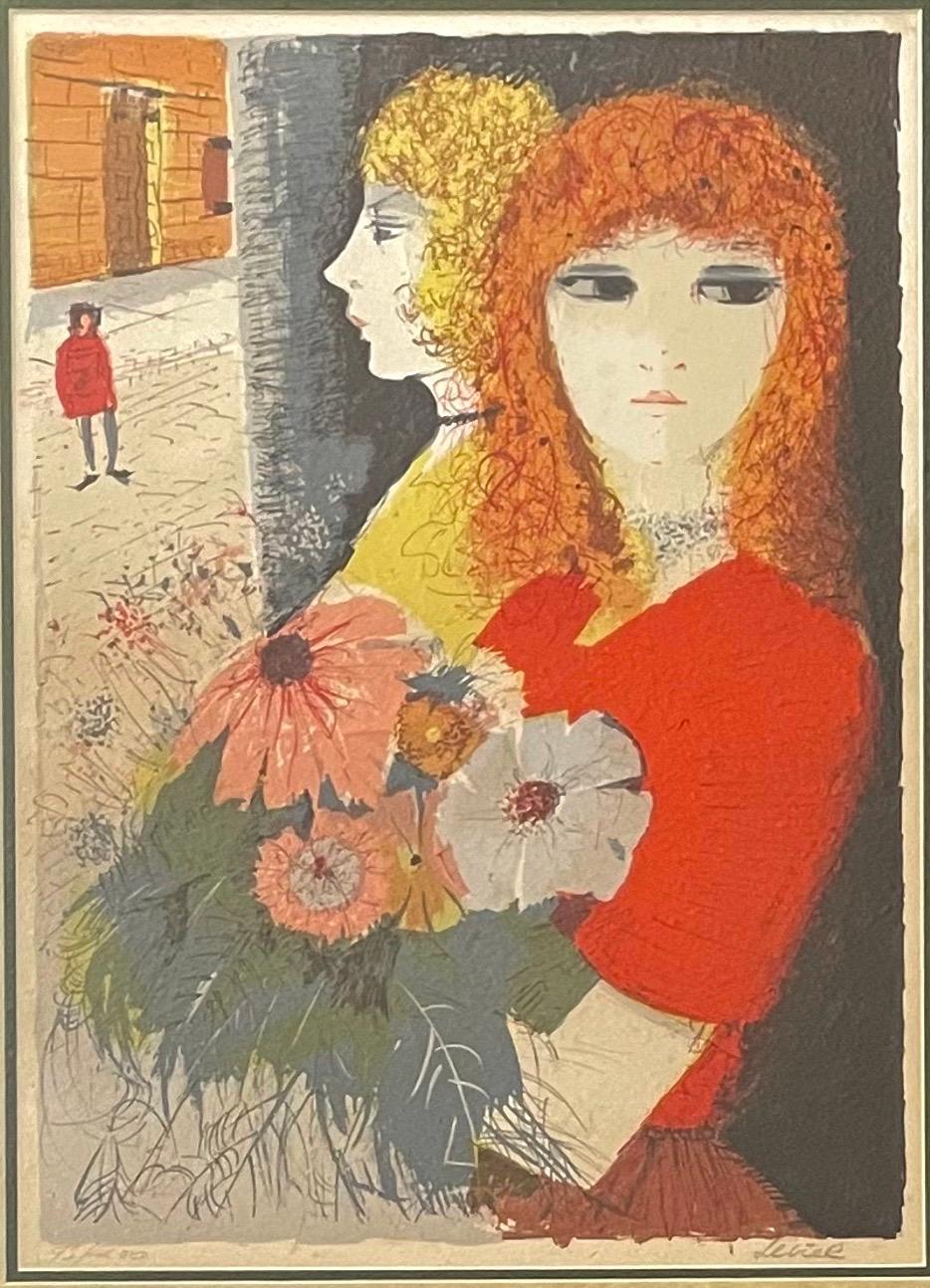Items Similar to The Hunter, Mid-Century Photo Realist Drypoint Etching Portrait, Limited Edition
Want more images or videos?
Request additional images or videos from the seller
1 of 8
Gilbert SchoenbrodThe Hunter, Mid-Century Photo Realist Drypoint Etching Portrait, Limited Edition1937
1937
About the Item
An incredible photo-realist drypoint etching of a Native American man by Gilbert Adam Shoenbrod (American, 1903-1996), 1937. Titled "The Hunter", this hyper detailed portrait depicts the man at work on his craft.
Created in 1937 with an edition of 50.
Signature signed in pencil, lower right margin.
Framed and triple matted; off-white metal frame.
Shipped without glass. Image, 6"H x 8"W.
The artist was from Highland Park, IL and active in Pacific Grove, CA. He exhibited drypoints at the Chicago Society of Etchers and Brooklyn Society of Etchers exhibits in the 1930’s. The National Museum of American Art has 2 of his prints.
Studied drawing and biology at Stuyvesant High School, long recognized for technical and scientific excellence. The groundwork for meticulous detail and accuracy was laid at New York University in his studies of the microscopic structure of the cell. Attended the College of Physicians and Surgeons, Columbia University, he left medical school to study painting and sculpture at Yale University. At 40, he returned to Columbia, but this time to the school of education where he earned a master's degree and taught. While at the University, he met an Arabian silversmith who became a close friend, enhancing Gilbert's interest in the eastern handicrafts. Under a master's instructions he acquired the ancient skills of metal craft and jewelry-making. In 1948 on a trip to the West Coast he discovered Carmel and in the following year moved to that haven of artists to open his own studio for handcrafted jewelry.
Biography form the Pacific Grove Tribune Wednesday, September 15, 1971.
Smithsonian Records Grovian’s Career by Iona Logie:
Against the blazing sunset of the matchless August evening, in Pacific Grove, a slight intensely blue-eyed man of slim and youthful stature stands erect on his balcony. His every line is a prayer and a paean to man’s longing for inner perfection. Since dawn, he has been engrossed in studio and workshops fronting the blue Pacific. His day is done at sundown; he will rise to greet the morning light-and set to work again.
The paintings, drawings and writings of this new artist on the national scene have been selected by the Smithsonian Institute in Washington to be preserved in microfilm in the archives of a dawning art in American painting and thought. The works of Gilbert Adam Schoenbrod ( Gilbert Adam) are now recognized as a well-defined clearing in the confusion of the day. They cut through the maze of man's own creating, to arrive at a basic framework of order, showing man's place and purpose in the viewers.
To many viewers, the Schoenbrod portraits of his fellow man whether drawings, paintings or etchings, brain brain to mind a complex of Rembrandt, William Blake, Kahlil Gibran, and Leonardo da Vinci. The faces, drawn from the depths of consciousness, over the soul of man to reveal in nakedness his dreams, his hopes, his fears, and his determination to find self truth, and goals of deepest meaning. With picture and word, the artist spreads out for viewing the anatomy of the whole, from cosmic beginning to present, and on into the future. He places the struggling in the now within the tide of progression, supplying the key of perspective for reevaluation and orientation in the seeming hopelessness of today's distracted way of life.
CHICAGO
This artist-resident of Pacific Grove was born in Chicago in 1903. His parents were from old Russia, and in his work he shows the depth and warmth of his Eastern heritage-- more especially in the etchings of scholars and ancients. His early childhood was spent in Texas as well as Chicago. Later in New York, he acquired the first useful skills in drawing at Stuyvesant High School, long recognized for technical and scientific excellence. The groundwork for meticulous detail and accuracy was laid at New York University in his studies of the microscopic structure of the cell.
In preparation for a career in medicine,Schoenbrod specialized in biological sciences, but also took time from studies to travel and explore the world of industry. He worked on a New England farm, put in night hours on the assembly line of a shingle factory.
For a time, he was an oiler of locomotives in the roundhouse of the New York, New Haven and Hartford Railroad. He shipped out as a seaman on coal boats plying the North Atlantic coast, and on freighters of South America. Everywhere he was soaking up memories of people, and of vastly different ways of life.
At the College of Physicians and Surgeons, Columbia University, Schoenbrod entered upon medical studies, learning through dissection the intricacies of human anatomy. It was during this period that he realized his goal was to be in the wellness of man, not the illness. He sensed an imperative need to pursue the talent for drawing, and left medical school to study painting and sculpture at Yale University.
COLUMBIA
On holiday in New York City, Schonebrod met Florence Symonton, who became his wife and the mother of their two sons. One is now a hospital pathologists, the other works at present on the restoring of antiques. Meeting and hearing Mrs. Schoenbrod even now, one senses that she might well have been an actress or a coach in speech and drama; her diction and voice are music, her natural air and style dramatic, as might be expected from her Irish theatrical heritage.
In both New York and Chicago, Gilbert Schoenbrod was able to channel his artistic powers into 20 productive years of advertising design and illustration. At 40, he returned to Columbia, but this time to the school of education where he earned a master's degree and taught. While at the University, he met an Arabian silversmith who became a close friend, enhancing Gilbert's interest in the eastern handicrafts. Under a master's instructions he acquired the ancient skills of metalcraft and jewelry- making. In 1948 on a trip to the West Coast he discovered Carmel and in the following year moved to that haven of artists to open his own studio for handcrafted jewelry.
In the background was the constant thought that one day he would have something to say, and--when the time came—he hoped to have the skill to give it clear expression. The drawings accumulated in portfolios, for the most part unframed and unseen.
In the artist’s early 50s the urge to draw, and then to write, became a compulsion. He continued designed and make jewelry and become widely known for his skill and craftsmanship. But the jewelry weighed him down as the need for a deeper expression grew more intense. Inner pressures built up, and in 1956 the strain brought on a break of illness.
Intensive treatment and recovery, Schoenbrod feels, brought perspective and self-knowledge, the ultimate goal of the only effective therapy. He began to see the pattern of an entire life moving through preparation to fulfillment. His studies, his travels, his labors, his total experience as husband, father, teacher, artists and craftsmen, flowed into a channel toward an understanding and expression that would be his own unique contribution. He closed the Carmel jewelry studio, and with his wife retired -- first to his old studio in Connecticut, then to his present home overlooking the Pacific.
SMITHSONIAN
From 1957 to the present, he has been drawing, painting, writing. In April 1971 he gave his first one-man showing of work of the present period at the Saiset Museum and Gallery of the University of Santa Clara.
A book of his poems,”The Ecology of the Man Within,” related to the paintings on exhibition, was released in time for the show. It was then that the senior researcher of the Smithsonian Institute saw the artist work, and ask the curator to gather all available material related to schoenbrod’s life -- and send it to Washington.
Gilbert Adam Schoenbrod will reach his 70th year before long. He has searched for the elixir of a creative life. In his maturity he has found it and lived it. His work and his life are a unity. In his body is a vitality of youth. In his paintings there is a continuing flow of an age-old wisdom and the skills of a lifetime. In them there is a message for contemporary man. In an age so acutely in need of reconstructive ecology, the artist-author is now completing a timely book on food and exercise for the”Care of the Man Within.”
- Creator:Gilbert Schoenbrod (1903 - 1996, American)
- Creation Year:1937
- Dimensions:Height: 14.75 in (37.47 cm)Width: 16.25 in (41.28 cm)Depth: 1 in (2.54 cm)
- Medium:
- Movement & Style:
- Period:
- Condition:Some age toning to paper.
- Gallery Location:Soquel, CA
- Reference Number:
About the Seller
5.0
Platinum Seller
These expertly vetted sellers are 1stDibs' most experienced sellers and are rated highest by our customers.
Established in 1986
1stDibs seller since 2014
2,514 sales on 1stDibs
Typical response time: <1 hour
- ShippingRetrieving quote...Ships From: Soquel, CA
- Return PolicyA return for this item may be initiated within 14 days of delivery.
More From This SellerView All
- Mid Century Young Blonde Girl Portrait Egg Tempera - Style of Thomas Hart BentonBy Robert CollinsLocated in Soquel, CAGorgeous pointillist egg tempera portrait of young blonde girl by Robert Joseph Collins (American, 1922-2011), 1947. Signed "Collins" and dated "'47." U...Category
1940s Photorealist Figurative Paintings
MaterialsEgg Tempera, Illustration Board
- Two Figures on the Shore - Minimalist Landscape Drypoint Etching in Ink on PaperBy Doris WarnerLocated in Soquel, CATwo Figures on the Shore - Minimalist Landscape Drypoint Etching in Ink on Paper Minimalist landscape with two figures walking along the shore by Doris Ann Warner (American, 1925-201...Category
1980s Minimalist Landscape Prints
MaterialsPaper, Ink, Drypoint
- A Breach of Promise - Hand Colored Etching on Paper 1900 VictorianBy James DobieLocated in Soquel, CAVictorian-style drypoint etching by James Dobie (British, 1849-1911), after a painting by Walter Dendy Sadler. Printed in London by J. Brooker & Co. and ha...Category
Early 20th Century Victorian Figurative Prints
MaterialsPaper, Watercolor, Drypoint, Etching
- Figurative Etching of Two Girls in Gowns, Line DrawingBy Dorian KrauszLocated in Soquel, CADelicate drypoint etching of two girls by Dorian Krausz (American, b. 1948). Signed "Dorian Krausz" in the lower right corner. Numbered "196/300" in the lower left corner. Presented ...Category
Late 20th Century Contemporary Figurative Prints
MaterialsPaper, Ink, Drypoint
- "Bessie Smith" - Musician's Portrait Etching on Paper (A/P)Located in Soquel, CA"Bessie Smith" - Musician's Portrait Etching on Paper (A/P) Clean and modern drypoint etching of a jazz singer Bessie Smith by Maria Bennett (American, 20th Century). The singer is ...Category
1970s Modern Portrait Prints
MaterialsPaper, Ink, Drypoint
- Chester Cathedral - Drypoint Etching in Ink on PaperLocated in Soquel, CAChester Cathedral - Drypoint Etching in Ink on Paper Dramatic drypoint etching by J. Alphege Brewer (British, 1881-1946). This composition shows the interior of Chester Cathedral in Brewer's characteristic style - highly detailed and with strong contrast. The scene encompasses the cathedral from floor to ceiling, capturing the immense size of the building. There are several people in the scene which contribute to the sense of scale. Signed by hand "J. Alphege Brewer" in the lower right corner. Titled "Chester Cathedral" in plate, lower left corner. Includes original card with artist's name. Presented in a new black mat with foamcore backing. Mat size: 16"H x 12"W Paper size: 10.75"H x 7.75"W James Alphege Brewer was well known in the early 20th century as a producer of color etchings of European cathedrals and other scenes of church, college, and community. He was born July 24, 1881, in the Kensington section of London, England, the son of Henry W. Brewer, noted artist of historical architecture and prominent convert to the Catholic Church, and the grandson of John Sherren Brewer, Jr., “the brilliant editor of the Calendar of Letters of Henry VIII.” His great uncle was E. Cobham Brewer, the polymath who compiled Brewer’s Dictionary of Phrase and Fable. Among his older siblings were the artist Henry C. Brewer and the organist and writer John Francis Brewer. Brewer attended the Westminster School of Art in London, where his brother Henry also trained. In 1910, he married Florence Emma Lucas, an accomplished painter in oil and watercolor, whose father was the noted landscape artist George Lucas and whose great uncle was David Lucas, the famous engraver for John Constable. Florence's brothers Edwin and George assisted Brewer in the printing of Brewer's etchings. Brewer exhibited at the Royal Academy (RA) and the Royal Institute of Painters in Watercolour (RI), at the Paris Salon of the Académie des Beaux-Arts, and in the shows of the Royal Cambrian Academy (RCA). He became an associate of the Royal Cambrian Academy in 1929 and a full member in the last two years of his life. He was also a member of the Hampstead Society of Artists, the Society of Graphic Art, and the Ealing Arts Club, where he was first Honorary Art Secretary and then Honorary Art Chairman. Most of Brewer's larger etchings were published by Alfred Bell...Category
Early 20th Century Romantic Interior Prints
MaterialsPaper, Ink, Drypoint
You May Also Like
- Floating on the SunLocated in New York, NYEmilie Arnoux hails from Normandy, France. From a young age, she became fascinated by the ocean and the laid back lifestyle surf-culture engenders. Her work captures the divine energ...Category
2010s Contemporary Figurative Prints
MaterialsCanvas, Archival Ink
- Two Female Portraits - Original Tempera by Mino Maccari - 1920sBy Mino MaccariLocated in Roma, ITTo Female Portraits is an original modern artwork realized in the early 20th Century by the Italian artist Mino Maccari (Siena, 1898 - Rome, 1989). Original painting. Tempera on pap...Category
Early 20th Century Modern Portrait Paintings
MaterialsTempera
- SOAK UP ART WHEN YOU CANBy KunstrasenLocated in Aventura, FL6-color screen print on 300gsm Somerset fine art paper. Hand signed and numbered by Kunstrasen. From the edition of 100. Artwork is in excellent condition. Certificate of Authenti...Category
2010s Street Art Figurative Prints
MaterialsScreen, Paper
- untitled, boy with dog and violinLocated in Belgrade, MTThis lithograph is part of my private collection of 20th Century artists. It is original, signed and numbered by the artist. Philippe Noyer was a French postwar and contemporary arti...Category
Mid-20th Century Contemporary Figurative Prints
MaterialsPaint, Lithograph
- Winged - Framed Contemporary Limited Edition Print Angel (White+Blue+Pink)By Amy SmithLocated in Gilroy, CALimited Edition #2 of 20 Print of Original Artwork / Framed Dimensions 30" X 24" "Winged," by Amy Smith is an empowering image of a winged female. Smith uses photographs of her ...Category
2010s Pop Art Figurative Prints
MaterialsDigital
- Large Modernist Paris Street Scene Wine Shop Montmartre Cafe Ladies LithographBy Charles LevierLocated in Surfside, FLFramed 32 x 26 image 22 x 16 Charles Levier (1920-2004) He was born in 1920 of a French father and American mother in Corsica. He held a fascination with color and form that led him...Category
Mid-20th Century Modern Figurative Prints
MaterialsLithograph
